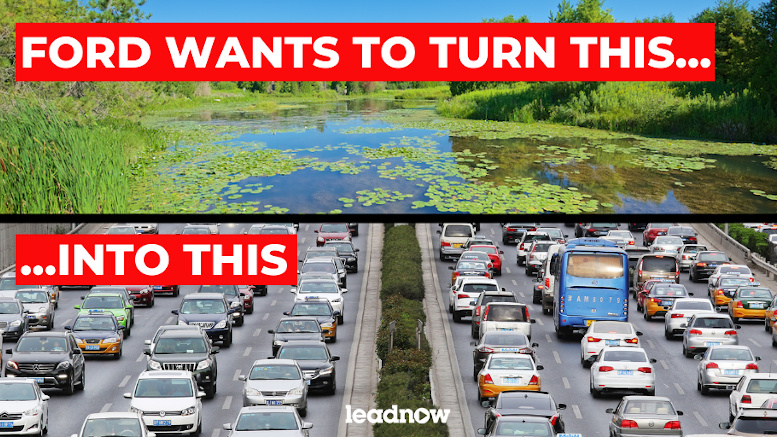Socialist Alternative recently examined the idea that Doug Ford had become the friend of labour after his government increased the minimum wage and proposed that delivery workers should be allowed to use washrooms at locations they deliver to and that workers should have the right to “disconnect from work” (not answer the phone, reply to emails etc.). Unsurprisingly, the article concluded that Ford’s labour-friendly credentials were only skin deep. Now Ford has had another “conversion,” with him receiving plaudits from many in the “green progressive” camp for his recent promotion of electric vehicles (EVs). However, the green misdemeanours of Ford, chronicled in detail in this article from The Narwhal, should disabuse those who might have illusions that Ford wears a green halo.
Ford in 2018 — sell off the Greenbelt, end electric vehicle consumer subsidies
It should come as no surprise that Doug Ford doesn’t exactly exude greenness. During the 2018 Conservative leadership campaign, Ford was caught on tape promising to open up a “big chunk” of Ontario’s Greenbelt (the world’s largest, permanently protected green space) with the obvious implication that he was making private deals with developers to open up the area for housing development. In fact, Ford admitted that the idea came not from him but the developers. There was a major public outcry when the tape became public, one MPP accusing Ford of wanting to “bulldoze a great swath of the Greenbelt and turn it into the largest condo farm this province has ever seen.” Ford was quickly forced into retracting his words, saying that the Greenbelt was safe in his hands.
Ford in 2018 — electric vehicles
So, has Ford become any greener in the intervening period? Hardly. With respect to EVs, he not only cancelled a rebate program for EV buyers shortly after taking office in 2018, but he also sanctioned the removal of charging stations from commuter-rail parking lots and cut a requirement for new homes to have EV chargers. “I’m not going to give rebates to guys that are buying $100,000 cars — millionaires,” he said at the time, cynically adding to his populist image as the premier who fights for “the little guy.” Not that Socialist Alternative sees EVs as the solution to carbon emissions in the transportation sector — on the contrary, there are substantial emissions associated with the production of EVs, they don’t address the problem of road congestion and most working-class people cannot afford them.
Ford in 2021 — EVs as a vote winner
So, Ford’s “green” conversion would appear to lie in a recent announcement encouraging the production of EVs. His EV strategy aims to have Ontario car manufacturers produce 400,000 electric cars and trucks a year by 2030 and to attract two or three battery plants. The province will partner with the auto industry to prepare it to make the “car of the future” and “establish and support a battery chain ecosystem” using the mineral wealth in Northern Ontario. This partnership will take the form of the Conservative government investing $295 million (matched by the same amount from the federal government) in the Ontario auto sector. Irrespective of how green a solution EVs really are, Ford’s strategy is going to run into a couple of problems. First, Ontario currently has little or no presence in the electric car battery supply chain. Lithium is the key element in electric car batteries, but there are no lithium mines, no lithium processing plants, and no battery makers in Ontario. Second, Ontario plants assemble about 1.6 million vehicles of all kinds annually now. But the success of any plan to convert the province into a hub of EV production hinges on beating back a tax credit, proposed by US President Joe Biden, that would favour American-made EVs. “Before the election, I didn’t believe in giving millionaires rebates on over $100,000 Tesla cars,” Ford told reporters. “Nothing against Tesla, they’re gorgeous cars. But, you know, I just didn’t believe in it. Let’s see how the market dictates.” In that regard, he’s showing some consistency in that he has not changed his mind about restoring the subsidies on price that EV purchasers used to get under the Liberals.
Eyes on the June election
Ford also has his eye on the provincial election coming up next June. While on the campaign trail in 2018, Ford vowed to bring back 300,000 manufacturing jobs he claimed the province had lost under previous Liberal governments. Apparently, he was convinced by long time Conservative donor and auto-parts manufacturer, Frank Stronach, to see the future of manufacturing in the production of EVs. So, the green “conversion” on electric cars has little to do with combating global warming and everything to do with helping the beleaguered Ontario auto industry recover its former prowess and, naturally, its profitability. And if the jobs are created, it won’t do his election chances any harm. True populist that he is, Ford tries to appeal to the demographic that relies on their cars for getting around, whether it be gas or electric. So, in southern Ontario, he thinks he will win votes by promising to build a new highway, supposedly to deal with congestion.
Highway to hell
The proposed Highway 413 passing through a stretch of southern Ontario would go through the Greenbelt and cost taxpayers (current estimate) $6 billion. Ford calculates that the highway will shave 35 minutes off the average journey while an independent inquiry, conducted four years ago, concluded that the savings would be a mere six minutes. “Right now, our 400-series highways are clogged with gridlock. Ask anyone who drives on them… They’re not suitable for the current needs of Ontarians,” said Ford. The region around Toronto will be growing by one million people over the next five years. But as the urbanist Jane Jacobs pointed out, building highways to reduce congestion is like loosening your belt to lose weight. History has shown that building new highways, in addition to destroying farmland, forests, wetlands and ecosystems, doesn’t actually solve chronic traffic jams. Numerous studies have revealed a phenomenon known as “induced demand,” which refers to the idea that increasing roadway capacity encourages more people to drive, thus failing to improve congestion.
An investigation by Torstar and National Observer found eight powerful developers, many of them prolific Tory donors, owned over 3,300 acres of land near the highway’s proposed path, which could skyrocket in value if the highway was built. Apart from pleasing the developers, Ford is relishing the likely political fight on this issue at election time. Both the provincial Liberals and NDP are opposed to the highway and Ford is framing the issue in terms of the tree hugging, liberal city elites versus working- and middle-class drivers wanting to reduce their commute times.
Environmental cuts — Ford “proud” of cancelling clean energy projects
Ford’s first year in office saw big cuts to spending on nearly everything but the Conservatives made some of their largest cuts to environmental initiatives. For example, there was the elimination of about 70 percent of provincial funding for the Anishinabek/Ontario Fisheries Resource Centre, a non-profit that helps more than three dozen Indigenous communities protect endangered wildlife and natural resources. And as part of broader cuts to legal aid clinics, the government dropped its funding to the Canadian Environmental Law Association by 30 per cent. Another casualty of the 2019 budget was $4.7 million in annual funding allotted to the 50 Million Tree Program run by the non-profit Forests Ontario. The Ford government also slashed the budget of the Ministry of the Environment, Conservation and Parks by about a third in 2019. Those cuts resulted in the Environment Ministry cutting the staff responsible for inspections and enforcement for hazardous spills by 9 percent.
Groups like Eco-Justice have chronicled how the Ford government has launched a number of attacks on environmental protections, including making major changes to Ontario’s Environmental Assessment Act, the Planning Act and other environmental laws without consulting Ontarians as required by the province’s Environmental Bill of Rights. The Liberal government had introduced a cap-and-trade scheme to deal with CO2 emissions. It wasn’t far reaching or particularly effective but at least the revenues generated through the program were dedicated to green energy projects. Ford’s decision to end cap-and-trade spelled, among other things, the end of a $100 million budget for school repairs, a $337 million fund that offered people rebates to retrofit their homes and businesses with energy-saving technologies, together with another 227 clean energy programs.
A week after ending the cap-and-trade program, the Ford government cancelled 758 renewable energy contracts, including hydroelectric, solar and wind farms that were mid-construction. Ford talked of “those terrible, terrible wind turbines.” The complete list also included solar rooftops on schools, libraries, community and municipal buildings. The Ford government spent more than $230 million to cancel these projects, a decision Ford said he was “proud” of.
At the end of November, Auditor General Bonnie Lysyk delivered a scathing report on the province’s failure to reach emission targets to tackle climate change. She estimated that its current policies could reduce emissions by only 3.4 megatonnes by 2030 — or only about 19 percent of the target. Lysyk highlighted the biggest sinner in terms of reaching targets: “the Environment Ministry fully met just 18 percent of our criteria.”
A socialist response
It should be clear that Ford’s “green conversion” is anything but. It is as much a sham as is his so-called labour-friendly face. To the production of EVs and construction of new highways, Socialist Alternative would counterpose a massive investment in free, accessible public transit. In addition, we propose:
- Massive public investment in clean renewable energy, housing and building insulation and retrofitting, and energy saving to quickly move to a clean energy system.
- Take the profit out of energy. Public ownership of the top energy companies to protect jobs and convert them to clean energy. Phase out the Tar Sands and nuclear power.
- Expand green jobs. Provide guaranteed paid re-training and new good paying jobs in socially useful production for all workers in phased-out industries.
- End built-in obsolescence and waste. A full program of re-use and recycling.
- Public ownership of natural resources, water and fisheries.
- Democratic planning, management and public ownership to ensure protection of the environment, eco-systems and biodiversity.
- Social justice so the poor and working people do not pay for environmental actions.
- End subsidies to polluting and environmentally damaging companies.
- For people and the planet, not profits.



